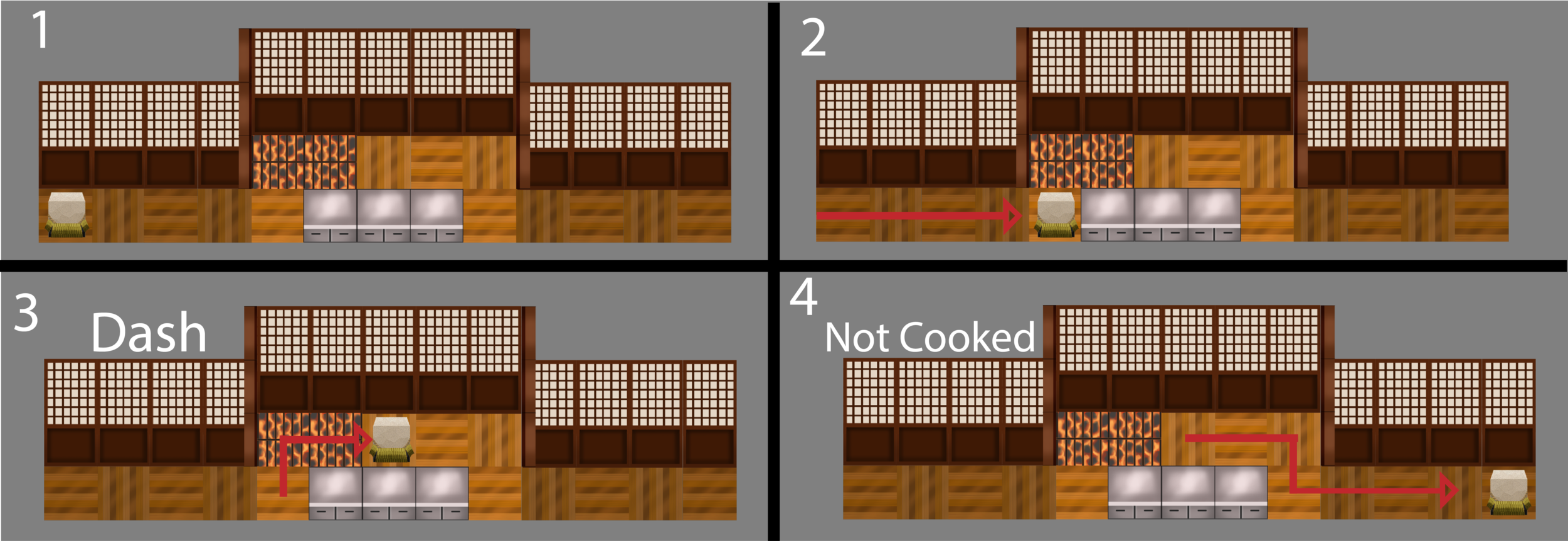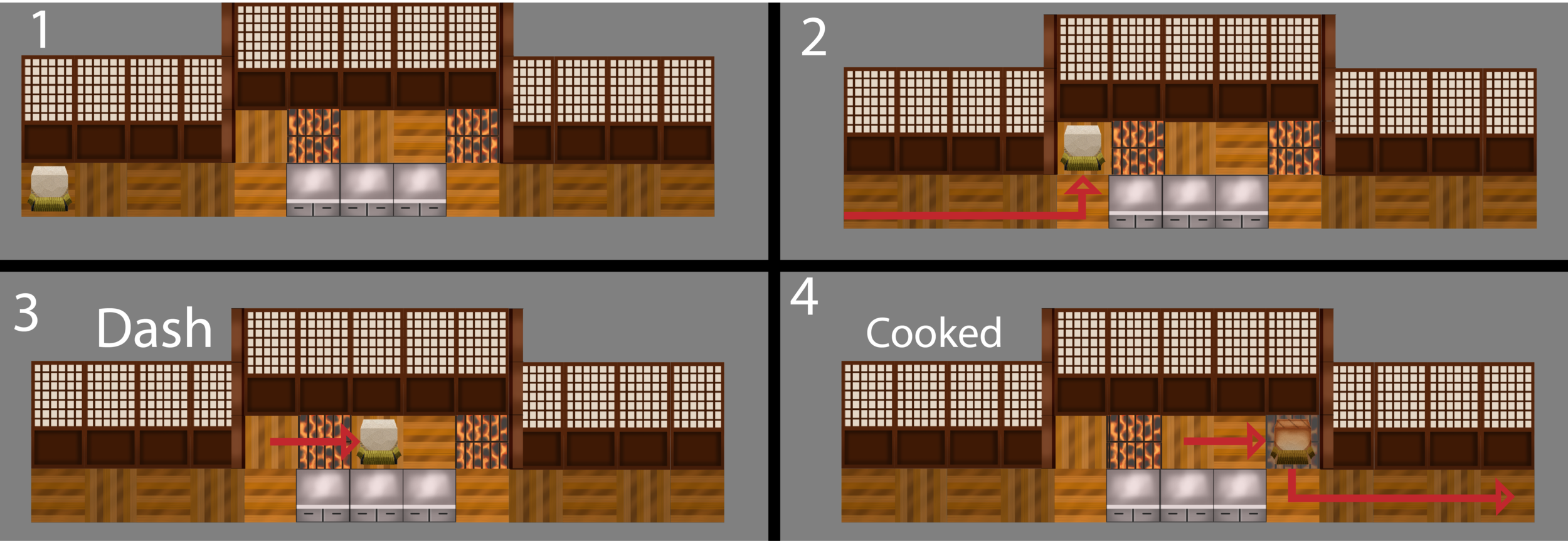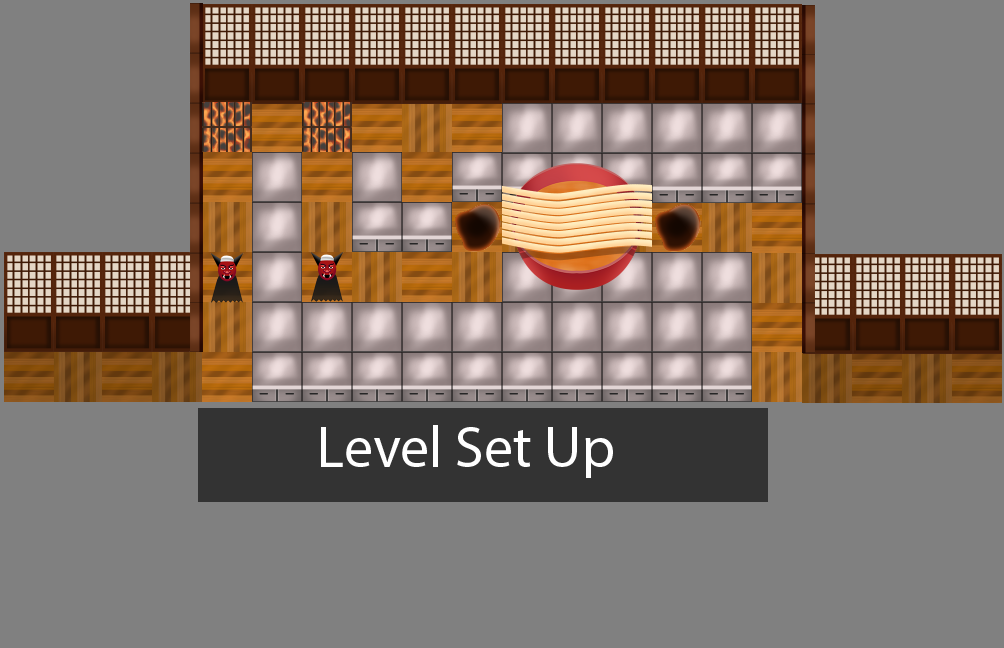ToFu Dynasty
Tofu Dynasty Info:
Project Length: 3 Months
Genre: Tower Defense
Team Size: 4
Role: Lead Designer/Producer
Tofu Dynasty is a tablet game for an older adult audience where the player is a monster chef who seeks, through the use of various food-based traps, to cook the various tofu heroes that come through their dungeon into an exquisite dish. More specifically, the game works much like a tower defense except instead of towers the player places traps, and instead of wanting to kill all the enemies they would want to only partially damage them before they got to the end of a dungeon. However, while the end result was a goofy casual cooking based trap defense, the game did not really start off that way at all. In fact, at the start of our development cycle we had a very different game.
Brainstorming and Initial Concepting:
This was our initial step in my team’s development process. We came up with a bunch of random ideas and then discussed them to see which ones could be combined to make decent game concepts. From this process we had three initial ideas for what we could turn into a game. The first was an idea of a plat former called Stitch a Limb were the player would be a teddy bear and fight other creatures for their abilities to traverse the level. The second idea was called Healing During Combat, which had the player take command of a group of RPG characters as they tried to heal a patient while fighting monsters. Finally, our third idea was about a reverse dungeon crawl where the player would be the final boss of the dungeon and wanted the heroes to get to it just hurt enough to be finished off by the player. After some initial concepting, QA testing, and risk easements we found the reverse dungeon crawl idea had the most potential.
Porject Goals:
The Core mechanic for our Reverse Dungeon Crawl game was the player had waves of enemies that were coming through their dungeon full of traps. However, they did not want to completely kill these enemies. Instead they wanted them to be at low health by the time they got to the end of the dungeon. The goal for this game was to access an older target audience of more casual gamers, and to have play sessions of up to five to ten minutes. Also looking at similar games in the tower defense market, like Castle Rush, the game should be simple and easy to understand. The team decided to go with a 3D art style based off of kokeshi dolls, we also decided to give the game a very Japanese style theme. From here the game was called Ryuu’s Labyrinth, making the end boss the player a dragon draining the souls of heroes as they got to the end of the Labyrinth, hurt and unable to fight back.
Heroes
With the games goals set, the mechanics could be developed as well. I wanted the game to remain simple and easy to understand and yet reward player’s skill and knowledge about the game. I started by condensing the team’s ideas where heroes come down into three enemy hero types that could enter the Labyrinth.
First was the Samurai, a hero that would have a high health.
Second, the Ninja who would have a medium health and be able to avoid certain traps.
Third, the Priestess who would have a low health but be able to take less damage or ignore certain traps.
Traps
Now the traps, based on the nature of traps, had a small reset time before they were ready to go off again. I designed four different traps.
First, there was a spinning axes trap that would do high damage to most heroes but would have long reset time.
Second, there was the minion, basically a minion of the final boss who would do a low to moderate amount of damage.
Third, was the slow which had a reset time but did no damage. Rather it slowed down any hero who passed through it.
Fourth, there was the “you hand,” the trap door that was different than other traps because the player would mainly activate it by tapping on it
The mechanic of the players activating one of their own traps was meant to keep the player more involved with the game. Instead of just waiting for each wave of heroes to be over, the player might have to pay attention to the game to activate their trap doors.
Game Flow
The game flow started with the player being given a blank level grid with a start point. The heroes would come from and an end point where the final boss to the Labyrinth was. The player would be given a set number of walls and traps to lay down.
After the player laid down walls and traps, they would start the waves of heroes coming. The player would have to try to place their traps in such a way that they would hurt the heroes in the coming wave without outright killing them, and leaving them with a small amount of health when they faced the boss at the end.
Results:
During this process we were taking the game through Quality Assurance, and getting reviews from both faculty and other students. They were not very good.
The QA Players found that they had a hard time telling the difference between our different heroes.
They found the game confusing, and had no idea what they were doing.
They found the level confusing and wanted more pre-planned experience.
Our peers told us that our theme was very dark and did not fit with our more casual game type, and our art style was really not working with our kokeshi doll art.
Back to the Drawing Board:
Over the next couple of weeks, we went back to redraw our game theme and art style, which required the game play to partially change as well. We had to do this without sacrificing too much work that we had done already as we had moved on into our development cycle and had to meet deadlines. After a few ideas for changing the theme, we finally came up with a plan to concentrate on the dungeon boss eating the heroes. In fact, we should turn the heroes into food and have the traps be cooking them for the player as they prepare food for the final boss. From this we made the player into a kind of monster chef preparing tofu heroes to be eaten in their restaurant, and with this idea Tofu Dynasty was born. We also changed the art style away from being 3D and to 2D. This let our artist make new assets for the game much faster.
Trap Re Design
For most of the traps, they became a re-skins of what they were before with few drastic changes.
The trap doors became a noodle bowl with a bridge of collapsible noodles over it.
The Axe Trap became a burning hot grill.
The minion became an Oni sous chef.
The slowing trap became of pool of teriyaki sauce.
Each trap’s reset, except the slow trap, was made the same amount of time.
The wall was no longer placeable. All the levels were pre-planned.
Finally, a mechanic was added where the player could tap on different traps to deactivate them. This would turn off the trap and stop them from damaging the Tofu Heroes as they passed over. This was both to increase the games active component and allow players to stop already cooked heroes from getting burned. After they passed, the player could tap the trap again to set it back to active.
Hero Re Design
The Heroes were changed into Tofu Heroes. I gave them different amounts of health. However, they would no longer take different damage from different traps. Rather, each trap would deal a set amount of damage to the Tofu Hero if they activated the trap. To make each Tofu hero different, I gave them each different abilities that they could use to escape the traps.
The Samurai Had the abilities to dash over traps on a cool down
The Ninja could take diagonal moves and would ignore all traps damage besides the Noodle bowl trap.
The Priestess would deactivate all the traps around them every X number seconds. This was the same deactivation the player used, so they could turn their traps back on by tapping them again.
Next, I changed how Tofu Heroes displayed their health, from a health bar, to stages of how cooked they looked. Our team’s artist made assets for the different stages of cooking for the Tofu Heroes. This meant that, still following the games core mechanic, the player wanted to cook all the Tofu Heroes to the well done state: not too raw and not too burned.
As for core game flow, it did not change too much. Player’s still laid down their traps before the Tofu Heroes came. However, they would then have to worry about activating and deactivating certain traps to make sure Tofu Heroes were properly cooked. Also, we stop marking the start and end of the maze and just have the Tofu Heroes go from left to right. When a level was over the player would be scored with a five star restaurant score rating, based on how well cooked each Tofu Hero was at the end of the level. Finally, I made a level progression that included tutorial levels to teach players how to play the game.


















